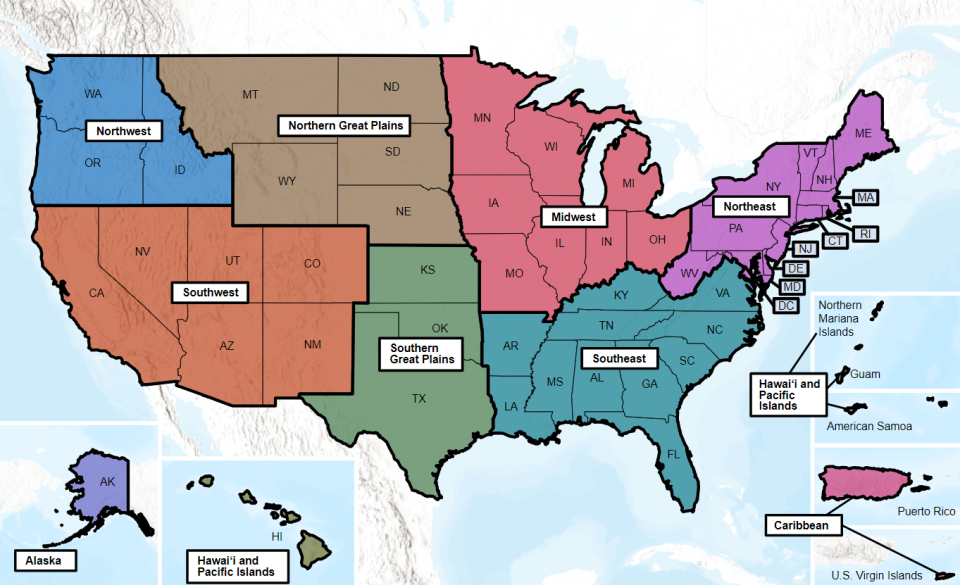Climate Change Connections: Texas (Football)
Climate change is impacting all regions and sectors of the United States. The State and Regional Climate Change Connections resource highlights climate change connections to culturally, ecologically, or economically important features of each state and territory. The content on this page provides an illustrative example. As climate change will affect each state and territory in diverse ways, this resource only describes a small portion of these risks. For more comprehensive information about regional climate impacts, please visit the Fifth National Climate Assessment and Climate Change Impacts by Sector.
On this page:
Introduction: Football Is Deeply Rooted in Texas Culture and Economy
For many Texans, football is more than just a sport: it’s a source of state pride, identity, and tradition. Many communities across Texas come alive on Friday nights as families, friends, and neighbors gather to support their local teams. Friday night football games at local high schools are a cultural phenomenon that is well known beyond Texas state borders. Cheerleading teams and bands train year-round to accompany players and compete.
In addition to supporting community, football is also consequential to the state’s economy. All levels of play, from youth football through the National Football League (NFL), generate revenue through ticket sales, concessions, team merchandise, and broadcasting rights. This revenue extends beyond the stadium into college towns and host cities, benefiting local businesses, hotels, and restaurants. Additionally, football-related activities—including coaching, stadium operations, and sports media—support thousands of jobs in Texas.1
Climate Impacts: A Hotter, More Humid Football Season Could Affect Player Health
Since global temperature recordkeeping began in 1850, ten of the warmest years have occurred during the last decade (2014–2023).2 The world’s warmest year on record was 2023, which averaged 2.12°F above the 20th century and exceeded the preindustrial average temperature by 2.43°F.2 Heat waves are becoming more frequent and lasting longer in many major U.S. cities, including cities in Texas.3 Since the beginning of the 20th century, temperatures in Texas have risen nearly 1.5°F, and this warming trend is expected to continue.4 By 2036, the number of 100°F days per year in Texas is expected to nearly double, compared with the period from 2001 to 2020.5 High temperatures can create dangerous conditions for outdoor recreation, including football.

Football players who spend long hours outside during training or games are more susceptible to exertional heat illness,6 which is caused by vigorous physical activity in warmer conditions. High humidity levels also increase risks of heat-related illnesses,7 as humid air decreases the body’s natural ability to cool itself through sweat evaporation.8 The Heat Index (also known as “feels like” temperature) helps determine potential conditions for heat stress by considering humidity and ambient air temperature in the shade, though it does not account for the effects of wind speed or sunlight. Athletic organizations, including the National Collegiate Athletics Association (NCAA), increasingly use Wet Bulb Globe Temperature (WBGT) to determine heat conditions, as WBGT provides a more comprehensive picture based on ambient air temperature, sunlight, humidity, and wind speed. Intense conditioning workouts and packed practice schedules during the preseason in hot summer months can be especially dangerous for athletes.
Youth players are particularly vulnerable to health consequences of heat exposure, as they are not as efficient at regulating their core body temperature as adults and may also have challenges in maintaining sufficient fluid levels.9 Heat-related illnesses at any age can present as heat cramps, heat syncope (fainting or dizziness), and heat exhaustion. Severe heatstroke is an acute medical emergency where the body’s temperature rises rapidly, the ability to sweat fails, and the body cannot cool down.
Poor Air Quality and Extreme Weather Events Can Affect Football Season
Climate change is expected to lead to poorer air quality in many parts of the country.10 Heat and poor air quality are linked, as warm and stagnant air can increase the ability of greenhouse gases to further trap heat.10 Hot sunny days associated with a warming climate can increase ground-level ozone (a greenhouse gas) in some areas.10 Ground-level ozone exposure can negatively affect human health. People with asthma, children, and older adults are especially susceptible to ozone. Depending on exposure level, ozone can cause various health issues including coughing, damage to airways, and aggravation of asthma symptoms. Research on how air quality affects the performance of professional athletes found that poorer air quality increased interceptions thrown and decreased the overall performance of NFL quarterbacks.11 As warmer temperatures and heat waves become more frequent due to climate change, poor air quality will likely continue to affect player health and performance.
Texas has been affected by multiple billion-dollar disasters in recent years, including drought, extreme heat, wildfires, and hurricanes.4 Since 1900, Texas experienced more than 85 tropical storms and hurricanes,4 and these extreme events are projected to intensify with climate change.12 Extreme weather can lead to cancellations, postponements, or relocation of football games.13 in 2017, extensive flooding of fields led to closures and disruptions in play for students.12
Taking Action: Safer Play in a Changing Climate
Addressing climate change requires reducing greenhouse gas emissions while preparing for and protecting against current and future climate impacts. Communities, public officials, and individuals in every part of the United States can continue to explore and implement climate adaptation and mitigation measures. Athletic organizers and staff can take steps to promote safer playing conditions, including:
- Heat education and hydration. Frequent water breaks and shade are important for keeping athletes safer in the heat.13 Wearing loose, light clothing is an additional strategy to help stay cool. Education efforts about the importance of these measures, along with how to recognize the telltale signs of heat stress, can protect people.
- Safer practice schedules. Avoiding athletic activities outside during the hottest part of the day and during the summer can reduce risk. Early morning or evening are typically cooler than mid-day and can be better times for practice. The Texas University Interscholastic League activity guidelines specify that all scheduled outdoor workouts should be cancelled at or above 92.1°F and organizers should limit practice duration and equipment worn starting at 87.1°F.14 Shifting practice and game times to cooler parts of the day, including nighttime, can also reduce heat risks and protect players.
- Climate-resilient design. Football fields and stadiums can be designed and renovated with heat protection as a goal. Because artificial turf can radiate more heat than grass, using grass fields can help keep temperatures down on the field.15 For spectators facing high temperatures, misting fan areas can be an effective cooling technology, as water droplets evaporate and cool the air.16
To learn more about climate change impacts in Texas and the Southern Great Plains region, see Chapter 26 of the Fifth National Climate Assessment.
Related Resources
- EPA Climate Change Indicators: Heat-Related Illnesses
- EPA Climate Change Indicators: Heat Waves
- Texas State Climate Summary 2022 (NOAA)
References
1 U.S. Bureau of Labor Statistics. (n.d.). May 2023 state occupational employment and wage estimates: Texas. https://www.bls.gov/oes/current/oes_tx.htm
2 NOAA. (2024). 2023 was the world’s warmest year on record, by far: Antarctic sea ice coverage hit record low. Retrieved July 10, 2024, from https://www.noaa.gov/news/2023-was-worlds-warmest-year-on-record-by-far
3 EPA. (2022). Climate change indicators: Heat waves. Retrieved February 6, 2023, from https://www.epa.gov/climate-indicators/climate-change-indicators-heat-waves
4 Runkle, J., Kunkel, K. E., Nielsen-Gammon, J., Frankson, R., Champion, S. M., Stewart, B. C., Romolo, L., & Sweet, W. (2022). Texas state climate summary 2022 (NOAA Technical Report NESDIS 150-TX). NOAA National Environmental Satellite, Data, and Information Service. https://statesummaries.ncics.org/chapter/tx/
5 Nielsen-Gammon, J., Escobedo, J., Ott, C., & Dedrick, J. (2020). Assessment of historic and future trends of extreme weather in Texas, 1900-2036. Texas A&M University Office of the Texas State Climatologist. https://climatexas.tamu.edu/products/texas-extreme-weather-report/index.html
6 Dee, S. G., Nabizadeh, E., Nittrouer, C. L., Baldwin, J. W., Li, C., Gaviria, L., Guo, S., Lu, K., Saunders‐Shultz, B. M., Gurwitz, E., Samarth, G., & Weinberger, K. R. (2022). Increasing Health Risks During Outdoor Sports Due To Climate Change in Texas: Projections Versus Attitudes. GeoHealth, 6(8), e2022GH000595. https://doi.org/10.1029/2022GH000595
7 EPA. (2023). Climate change indicators: Heat-related illnesses. Retrieved September 19, 2023, from https://www.epa.gov/climate-indicators/heat-related-illnesses
8 Buzan, J. R., & Huber, M. (2020). Moist heat stress on a hotter Earth. Annual Review of Earth and Planetary Sciences, 48(1), 623–655. https://doi.org/10.1146/annurev-earth-053018-060100
9 EPA. (2023). Climate change and children’s health and well-being in the United States (EPA 430-R-23-001). https://epa.gov/cira/climate-change-and-childrens-health-report
10 West, J. J., Nolte, C. G., Bell, M. L., Fiore, A. M., Georgopoulos, P. G., Hess, J. J., Mickley, L. J., O’Neill, S. M., Pierce, J. R., Pinder, R. W., Pusede, S., Shindell, D. T., & Wilson, S. M. (2023). Ch. 14. Air quality. In A. R. Crimmins, C. W. Avery, D. R. Easterling, K. E. Kunkel, B. C. Stewart, & T. K. Maycock (Eds.), Fifth National Climate Assessment. U.S. Global Change Research Program. https://doi.org/10.7930/NCA5.2023.CH14
11 Heintz, E. C., Scott, D. P., Simms, K. R., & Foreman, J. J. (2023). Air quality Is predictive of mistakes in professional baseball and American football. International Journal of Environmental Research and Public Health, 20(1), Article 1. https://doi.org/10.3390/ijerph20010542
12 McPherson, R. A., Fay, P. A., Alvarez, S. G., Bertrand, D., Broadbent, T. L., Bruno, T., Fares, A., McCullough, B., Moore, G. W., Moorhead, B., Patiño, L., Petersen, A., Smith, N. G., Steiner, J. L., Taylor, A., & Warziniack, T. (2023). Ch. 26. Southern Great Plains. In A. R. Crimmins, C. W. Avery, D. R. Easterling, K. E. Kunkel, B. C. Stewart, & T. K. Maycock (Eds.), Fifth National Climate Assessment. U.S. Global Change Research Program. https://doi.org/10.7930/NCA5.2023.CH26
13 Centers for Disease Control and Prevention. (2024). Heat and athletes. Retrieved January 24, 2024, from https://www.cdc.gov/extreme-heat/risk-factors/extreme-heat-and-athletes.html
14University Interscholastic League. (n.d.). Heat stress and athletic participation recommended plan. Retrieved September 19, 2023, from https://www.uiltexas.org/health/info/heat-stress-and-athletic-participation
15 Liu, Z., & Jim, C. Y. (2021). Playing on natural or artificial turf sports field? Assessing heat stress of children, young athletes, and adults in Hong Kong. Sustainable Cities and Society, 75, 103271. https://doi.org/10.1016/j.scs.2021.103271
16 Racinais, S., Hosokawa, Y., Akama, T., Bermon, S., Bigard, X., Casa, D. J., Grundstein, A., Jay, O., Massey, A., Migliorini, S., Mountjoy, M., Nikolic, N., Pitsiladis, Y. P., Schobersberger, W., Steinacker, J. M., Yamasawa, F., Zideman, D. A., Engebretsen, L., & Budgett, R. (2023). IOC consensus statement on recommendations and regulations for sport events in the heat. British Journal of Sports Medicine, 57(1), 8–25. https://doi.org/10.1136/bjsports-2022-105942

